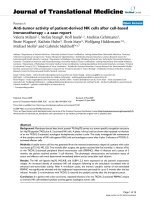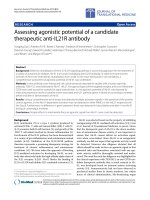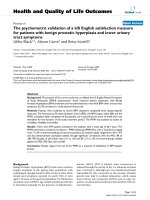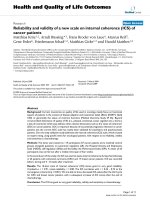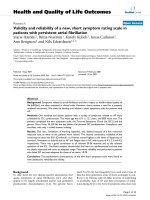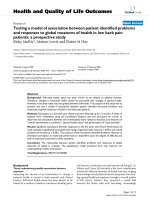Báo cáo hóa học: " Rhabdomyolysis: a manifestation of cyclobenzaprine toxicity" docx
Bạn đang xem bản rút gọn của tài liệu. Xem và tải ngay bản đầy đủ của tài liệu tại đây (177.76 KB, 2 trang )
BioMed Central
Page 1 of 2
(page number not for citation purposes)
Journal of Occupational Medicine
and Toxicology
Open Access
Case report
Rhabdomyolysis: a manifestation of cyclobenzaprine toxicity
Shiven B Chabria*
Address: Division of Hospital Medicine, Dept. of Internal Medicine, Waterbury Hospital, Waterbury CT, USA
Email: Shiven B Chabria* -
* Corresponding author
Abstract
A case of cyclobenzaprine (flexeril) overdose and the resultant rhabdomyolysis is presented. A
review of the range of clinical toxicity, management of overdose is described. The similarity of
cyclobenzaprine to the tricyclic antidepressant class is emphasized; this report attempts to
disseminate related information on this commonly prescribed centrally acting muscle relaxant.
Background
Cyclobenzaprine (flexeril) after its synthesis in 1961 was
found to have limited antidepressant action with no sig-
nificant advantage over other tricyclic antidepressants[1].
However it was found to act as a centrally acting muscle
relaxant and has been widely used ever since. Muscle
relaxants account for approximately 18.5% of all prescrip-
tions written for chronic back pain in the United States[2].
We present this case as an example of the range of
cyclobenzaprine toxicity and underline the treatment pro-
tocols used.
Case report
A 33 year old male was brought into the emergency room
after reportedly ingesting approximately 30 pills of 10 mg
each of cyclobenzaprine (flexeril) about 2 hours prior in
attempt to commit suicide. Vital signs on admission were
148/88 mm Hg 110/min 37.5 C On initial presentation
he was disoriented to time and place and person, the
patient was extremely agitated and confused. Airway was
well maintained and he did not require intubation. In the
emergency room gastric decontamination was achieved
with administration of ipecac with resultant emesis but
with only 4 pills returning. Thereafter the insertion of oro-
gastric tube was performed and gastric lavage with normal
saline was performed till clear return occurred and
approximately 7 more pills returned. Thereafter 30 gm of
activated charcoal was administered through the tube.
Diagnostic studies were as follows: Hb, 14.6 gm%, Hct,
43.8% WBC 15, 300 with 78% polymorphonuclear leuco-
cytes. Arterial blood gas was as follows PH 7.32 PO2 130
mmHg PCO2 45 mmHg. Chem 10 was unremarkable on
presentation, liver function testing revealed elevated ALT
of 39 U/L and AST of 30 U/L both normal. The AST
peaked to 298 U/L about 12 hours later and trended
towards normal over the course of the next few days.
Urine toxicity screen was negative, a qualitative screen was
positive for cyclobenzaprine a quantitative screen was not
available. Creatine Kinase was elevated on admission at
11,963 U/L peaked to 29,840 U/L in 24 hours and trended
towards normal in 4 days. EKG showed sinus tachycardia
with frequent premature atrial contractions and infre-
quent PVC's. Chest x-ray and CT scan of the head were
within normal limits.
The patient was monitored in the intensive care unit. He
was aggressively hydrated, cardiac monitoring showed
tachycardia which resolved on day 3 of his admission. The
patient remained agitated for 48 hours after presentation
and required frequent sedation. Urine output dropped
Published: 17 July 2006
Journal of Occupational Medicine and Toxicology 2006, 1:16 doi:10.1186/1745-6673-1-16
Received: 02 May 2006
Accepted: 17 July 2006
This article is available from: />© 2006 Chabria; licensee BioMed Central Ltd.
This is an Open Access article distributed under the terms of the Creative Commons Attribution License ( />),
which permits unrestricted use, distribution, and reproduction in any medium, provided the original work is properly cited.
Publish with BioMed Central and every
scientist can read your work free of charge
"BioMed Central will be the most significant development for
disseminating the results of biomedical research in our lifetime."
Sir Paul Nurse, Cancer Research UK
Your research papers will be:
available free of charge to the entire biomedical community
peer reviewed and published immediately upon acceptance
cited in PubMed and archived on PubMed Central
yours — you keep the copyright
Submit your manuscript here:
/>BioMedcentral
Journal of Occupational Medicine and Toxicology 2006, 1:16 />Page 2 of 2
(page number not for citation purposes)
and creatinine rose to 1.8 twenty four hours into his
admission, this responded to fluid boluses and creatinine
thereafter trended towards normal. His mental status
improved gradually to being fully oriented on day 4 and
he was transferred to a floor bed. A psychiatry consult
opined he wasn't actively suicidal. He was discharged on
day 6 and on follow up in the clinic a week thereafter was
doing well with no active issues.
Discussion
Cyclobenzaprine is a muscle relaxant acting primarily on
the central nervous system. It is structurally similar to
Amitryptilline, differing by only one double bond.
Cyclobenzaprine is a weak inhibitor of presynaptic nore-
pinephrine and serotonin. Skeletal muscle relaxant activ-
ity is due to brainstem mediated inhibition of gamma
motor neurons. Range of toxicity is similar to tricyclic
antidepressant overdose. Anticholinergic symptoms pre-
dominate, extreme cases may manifest with cardiac dys-
rhytmias and seizures. Hypo and hypertension have been
documented. In a series of 404 cases, adults ingesting less
than 100 mg remained asymptomatic. Toxic and Anti-
cholinergic symptoms occurred at doses greater than 100
mg.
Range of toxicity may be manifest by only Anticholinergic
symptoms like blurred vision, dry mucous membranes,
urinary retention and mydriasis. Tachyarrhythmia's
include sinus tachycardia which is very common however
even ventricular tachycardia unresponsive to ACLS has
been reported. Respiratory failure may develop and in a
series of 402 patients about 3% required mechanical ven-
tilation[3]. Delirium, agitation, disorientation and hallu-
cinations have developed even at therapeutic doses. This
is especially common in geriatric age group patients[4].
These same symptoms are fairly common after poisoning
and overdose[5]. Gastrointestinal effects range from nau-
sea and vomiting to constipation and loss of appetite.
High doses might produce hepatic damage with steatosis.
Acute renal insufficiency has been reported in case
reports[6]. Acid base disturbances manifest as metabolic
acidosis. Rhabdomyolysis is an uncommon complication
that may develop with prolonged agitation as was most
likely in the case presented above. We found only one case
description where cyclobenzaprine's range of toxicity was
associated with significant Rhabdomyolysis[7]. Psychiat-
ric effects may occur with therapeutic or overdose levels
manifesting as agitation, hallucinations, and even precip-
itation of acute manic psychosis[8].
The management of cyclobenzaprine overdose should fol-
low the same pathway as any tricyclic drug. Gastric decon-
tamination is fairly effective because the Anticholinergic
effects of cyclobenzaprine delay gastric emptying and
therefore it becomes possible to obtain tablet residues
even after significant time elapse. Ventricular arrhythmias
QRS widening, or intraventricular conduction abnormal-
ities should be treated with sodium bicarbonate 1 meq/kg
IV bolus and repeated if arrhythmias persist this should be
followed by IV infusion of sodium bicarbonate to pro-
duce an arterial pH of 7.5. The mechanism of action of
sodium bicarbonate is unknown. Severe Anticholinergic
effects can be reversed with the use of physostigmine sali-
cylate 1 to 3 mg IV. Careful cardiac and hemodynamic
monitoring is recommended in the first 48 hours to man-
age signs of cardiac toxicity and hypotension. Use of phys-
ostigmine is not recommended with EKG changes or wide
QRS changes[9]
References
1. Share NN, McFarlane CS: Cyclobenzaprine : A novel centrally
acting skeletal muscle relaxant. Neuropharmacology 1975,
12:675-684.
2. Luo X, Pietrobon R, Curtis LH, Hey LA: Prescription of nonster-
oidal anti-inflammatory drugs and muscle relaxants for back
pain in the United States. Spine 29(23):E531-7. 2004 Dec 1
3. Levine B, Jones R, Smith ML: A multiple drug intoxication involv-
ing cyclobenzaprine and ibuprofen. American journal of forensic
Med Pathology 1993, 14:246-248.
4. Douglass MA, Levine DP: hallucinations in an elderly patient
taking recommended dose of cyclobenzaprine. Archives of
internal Medicine 2000, 160:1373.
5. Linden CH, Mitchiner JC, Lindzon RD: Cyclobenzaprine overdos-
age. J Toxicology clinical toxicology 1983, 20:281-288.
6. Engel PA, Chapron D: Cyclobenzaprine induced delirium in two
octogenarians. Clinical psychiatry 1993, 54:39.
7. O'Riordan W, Gillete P, Calderon J: Overdose of cyclobenzaprine
the tricyclic muscle relaxant. Annals of Emergency Medicine 1986,
15:592-593.
8. Ambre JJ: Cyclobenzaprine overdosage (letter). Annals of inter-
nal Medicine .
9. Newton RW: physostigmine salicylate in the treatment of tri-
cyclic antidepressant overdose. JAMA 1975, 231:941-943.


